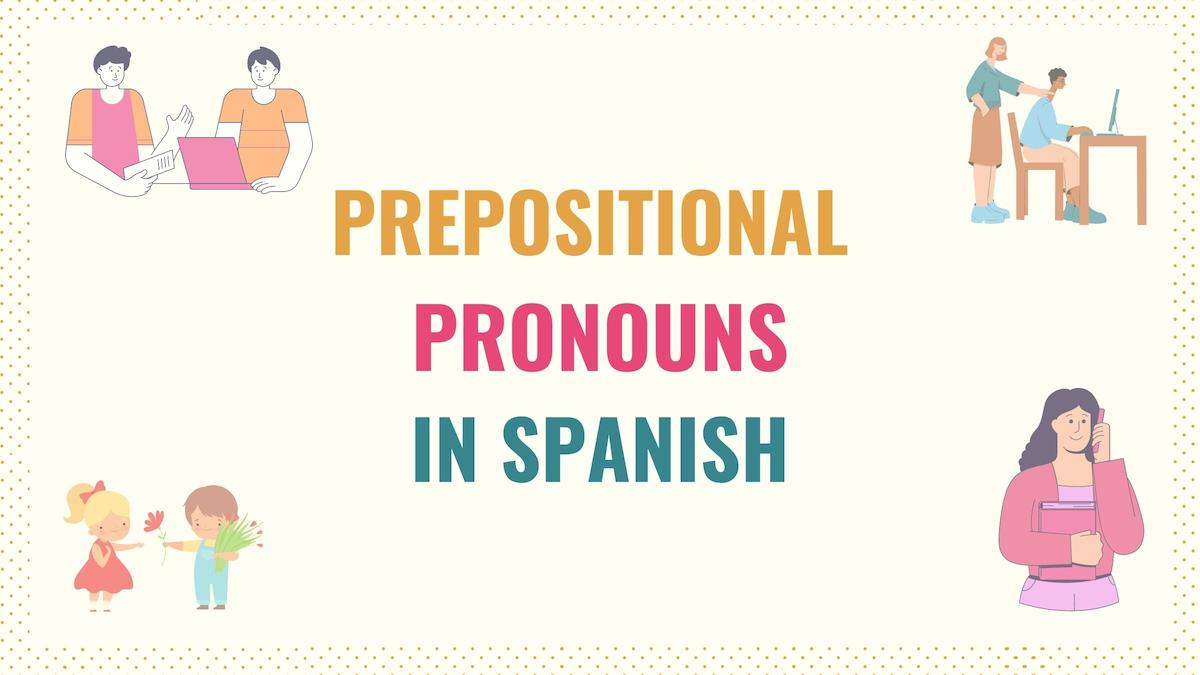In Spanish, we use different types of pronouns depending on their function in the sentence. In other words, the pronoun we use for a subject sometimes differs from the one used after a preposition. So, in this prepositional pronouns Spanish guide, we’ll go over:
- List of Pronouns After Prepositions
- When & How to Use Prepositional Pronouns in Spanish
- Spanish Pronoun Resources
By the end of this, you’ll know how and when to use these pronouns in Spanish.
What Are Prepositional Pronouns in Spanish
A prepositional pronoun is a pronoun that comes after a Spanish preposition. These pronouns are:
- Mí: Me
- Ti: You
- Él / Ella / Usted: Him / Her / You
- Nosotros / Nosotras: Us
- Vosotros / Vosotras: You (plural Spain)
- Ellos / Ellas / Ustedes: Them / You
As you can see in the prepositional pronoun Spanish list above, these pronouns are very similar to subject pronouns except for mí and ti.
[Preposition] + [pronoun]
A mí me gusta leer.
I like to read.
Este mensaje es para usted.
This message is for you.
No te preocupes por nosotros.
Don’t worry about us.
The prepositional pronouns listed above are used with most prepositions. However, there are some exceptions.
First, ‘mí’ and ‘ti’ cannot be used with the preposition con. In this case, they become the words conmigo and contigo, respectively:
No quiere ir conmigo.
She doesn’t want to go with me.
Finally, yo and tú are always used instead of ‘mí’ and ‘ti’ with the following prepositions:
- Entre: Between
- Excepto: Except
- Menos: Except / But
- Salvo: Except for
- Según: According to
Here are some sentences:
Todos me ayudaron menos tú.
Everyone helped but you.
Entre tú y yo no pasó nada.
Nothing happened between you and I.
Take Note: The Spanish pronoun me is also an object pronoun. However, me is not preceded by a preposition. For instance, me encanta leer. Keep in mind that mí without an accent can be a possessive adjective.
When & How to Use Spanish Prepositional Pronouns
As established before, a prepositional pronoun in Spanish is the pronoun we place after a preposition. Often, Spanish prepositional pronouns are used to emphasize or clarify who the object of a sentence is:
Te lo di a ti.
I gave it to you.
Este reloj es para ustedes.
This watch is for you.
If combined with de, these pronouns are used to express possession:
El celular es de ella.
The phone is hers.
¿Ese perro es de vosotros?
Is that dog yours?
Since the pronoun only completes the meaning of a preposition, you should check how prepositions in Spanish work.
Take: Mí and ti cannot be used with the preposition ‘de’ when expressing possession.
Next Steps: Resources for Spanish Pronouns & Prepositions
As their name suggests, Spanish pronouns after prepositions are specifically preceded by these types of words. In addition to this type of pronoun, you should also take the time to learn direct and indirect pronouns.
Certain verbs in Spanish take a prepositional pronoun. Since they can help you reinforce this topic and are crucial for communication, check this guide on verbs like gustar.
Download the Prepositional Pronouns PDF
Learning Spanish grammar topics like prepositional pronouns can be challenging for beginners and those who aren’t keen on learning the grammar of a new language. I’ve put together a free PDF cheat sheet you can download to make prepositional pronouns easier to understand and so you can revisit this topic whenever you’d like.

